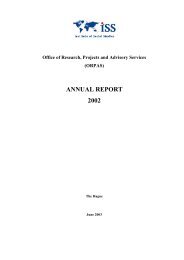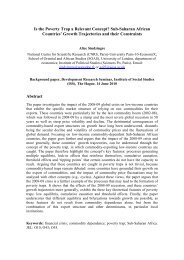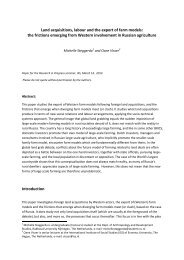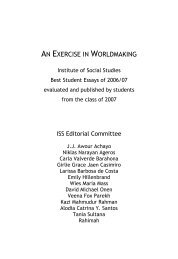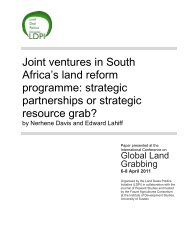AN EXERCISE IN WORLDMAKING 2009 - ISS
AN EXERCISE IN WORLDMAKING 2009 - ISS
AN EXERCISE IN WORLDMAKING 2009 - ISS
Create successful ePaper yourself
Turn your PDF publications into a flip-book with our unique Google optimized e-Paper software.
32 JONATH<strong>AN</strong> CONNOR<br />
mestizo landowners. As production became progressively less governable<br />
and less profitable, certain hacienda owners simply “gave up trying to<br />
preserve a particular regime of resource and social control, and sold their<br />
land to Quechua people” (Bebbington, 2007: 59). Peasants lacking the<br />
funds to acquire these lands themselves were frequently supported by<br />
NGOs and churches—collaborations that facilitated the transfer of the<br />
remaining hacienda land (Bebbington, 2000: 512). The result was a relatively<br />
equitable distribution of agricultural land throughout the canton.<br />
In addition to large-scale land redistribution, these early peasant struggles<br />
also helped to consolidate the region’s intercommunity federations,<br />
known in Ecuador as second-level organizations, or OSGs (Cameron,<br />
2003: 170). According to Carroll and Bebbington (2000: 214), an OSG is<br />
“a system of regional or multi-communal cooperation”. It operates at the<br />
meso level, establishing various internal and external linkages. Internal<br />
linkages include neighbor or kin-based networks, as well as intercommunity<br />
cooperation and support. External linkages refer to higher-level<br />
institutional linkages, such as the OSG’s relationship with state agencies,<br />
municipal and regional linkages, and relations between the OSG and civil<br />
society organizations or NGOs (Carroll and Bebbington, 2000). The<br />
aims and activities of OSGs can vary considerably. Some are more politically<br />
oriented and are primarily concerned with protecting and advancing<br />
the concerns of their members. Other OSGs act more as economic and<br />
developmental organizations, preferring to undertake livelihood initiatives<br />
and to facilitate the provision of local social services. In a context<br />
of state ‘rollback’ and privatization, these second-level federations can<br />
provide low-income households with vital economic and social services,<br />
often collaborating with NGOs and other development agents. However,<br />
many OSGs combine both political and economic activities. In this<br />
sense, their fundamental role “is to recapture dignity and voice in the<br />
political realm and to capture income flows and employment opportunities<br />
in the economic sphere” (Carroll and Bebbington, 2000: 227).<br />
In Guamote, these supracommunity federations played a leading role<br />
in transforming local governance structures during the 1990s. As their<br />
organizational capacity grew, they became increasingly involved in the<br />
canton’s municipal affairs. During the 1980s, Guamote’s OSGs began<br />
nominating and supporting indigenous candidates for positions on the<br />
municipal council. In 1992, they succeeded in electing the canton’s first<br />
indigenous mayor, and by 1996, they had effectively ended the mestizo




